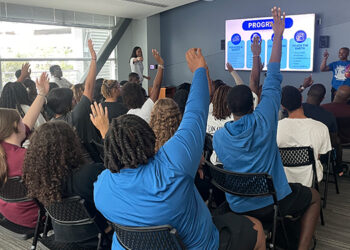Recruiting professional talent and hiring in the post-pandemic world is a challenge across all industries. Higher education, including campus recreation, is no exception to the “new normal” that now pervades the modern workplace. Decision makers are faced with navigating a complex maze that will hopefully lead to the best candidate.
However, as perceptions of higher ed change, employee demands for a more flexible work environment increase, and a desire to build more inclusive teams is prioritized. Hiring managers must avoid getting lost in the labyrinth and develop a search process that yields excellent short and long-term outcomes.
Hiring managers in campus rec should take the time to re-evaluate their traditional search process methods and update them to align with the contemporary job market. The following strategies can be used to bolster the strength and depth of a candidate pool.
1. Take a Proactive Approach to the Search
Are you truly trying to find the best talent or are you just filling a need? Too often hiring managers get caught up in replacing a departed employee as soon as possible. This is especially true in smaller departments that may already feel short-handed. Frequently, a job description can be too narrow and create a limited pool of candidates that may not yield desirable results or even produce a failed search. Proactive searches are driven by a more holistic approach that can produce greater long-term benefits.
Job descriptions should be carefully crafted to ensure they do not limit the candidate pool. Today’s hiring managers need to remain open minded and consider non-traditional candidates. These applicants may not have the exact previous experience expected for the position but possess transferable skills that are relevant to the role, as well as real life experience that merits serious consideration. Ultimately, the goal of any search should be recruiting professional talent that is best for your team.
2. Create a Dynamic Search Process While Still Following Procedures
A stale search process will often result in a stale candidate pool. Hiring managers need to organize a dynamic search while still abiding by all institutional, state and federal guidelines that are in place to mitigate risk and ensure equitable and fair hiring standards. Managers need to include multiple voices and diverse perspectives in their search committees. They also need to create clear expectations for what a successful candidate would bring to the organization in terms of experience, soft skills and cultural fit. A clear understanding will help guide the process for all involved.
3. Cast the Widest Net Possible
Today’s modern search processes have expanded well beyond classified ads. Hiring managers should utilize as many avenues as possible to promote job opportunities within their departments. Institutions have their standard platforms for promoting job openings, but managers should push for campus rec positions to be posted to resources available through NIRSA including Bluefish Jobs and NIRSA Connect community message boards.
But the net should also be cast to attract candidates with relevant experience outside of the higher ed realm. Certainly potential candidates exist in the worlds of parks and recreation or private recreation related businesses. As such, efforts should be made to reach those audiences through the appropriate channels. Of course, social media is another modern-day tool that managers need to utilize. Professional-based platforms such as LinkedIn prove to be a valuable asset to utilize when promoting an opening.
Finally, appealing to a diverse pool of candidates is also a significant priority if we are to ensure a search is equitable. A recent study conducted by the College and University Professional Association for Human Resources discovered that “70% of Black Americans and 60% of LGBTQ+ Americans aren’t convinced that higher education can offer a diverse, inclusive and equal opportunity work environment.”
The same study also revealed millennials and Gen Z have poor perceptions of higher ed as a career choice. Thus, managers are faced with the challenge of ensuring job postings are strategically targeted to diverse populations, while also selling their departments and institutions in a fashion that appeals to the widest audience possible across all spectrums and generations.
4. Clarify Growth Opportunities to Your Candidates
Let’s face the facts. Salary is not always going to be a driving factor in luring candidates into higher ed searches. In some instances, salary may be a serious impediment to finding the best talent possible. Yet managers need to be aggressive in demonstrating why a position in their department offers benefits that go beyond compensation.
Managers need to stress to candidates that there will be professional development opportunities. Hopefully, managers will be in a position where they can offer upgraded titles and increased job responsibilities to candidates as experience is gained at an institution.
Managers cannot have the attitude that developing talent only results in the individual being “poached” by another school or company. Managers must be proactive in both landing and cultivating talent. None of us can predict the future for any employee. However, if a positive work environment with growth opportunities is provided, that employee may decide to stay at an institution for an extended period of time because the culture is great.
5. Be Crystal Clear About Work Expectations
A major part of today’s search process has to be the inclusion of clear work expectations to the candidates. Managers need to be specific and up front about what their department and institution can offer. In the post-COVID workplace, many potential employees expect certain benefits, such as a flexible work schedule or remote work options. It’s imperative all benefits — from paid time off to remote or flexible work to tuition remission — are defined and clearly shared with candidates at the start of the search process. This level of clarity will help filter the candidate pool and retain individuals in the process.
In the end, a hiring manager still needs to follow the adage of “trust your gut” when recruiting professional talent. However, if the process is thorough and follows these best practices, the candidates in a search pool should provide excellent options to fill a position.










